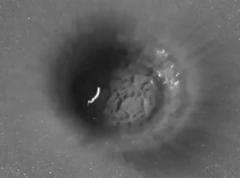June 1, 2010 report
Study investigates craters formed by raindrops (w/ Video)

(PhysOrg.com) -- Hiroaki Katsuragi and a team from Kyushu University in Fukuoka, Japan, have been investigating what happens when water drops of various sizes are allowed to fall from a height of 10 to 480 mm onto a granular target consisting of grains of silicon carbide with grain sizes ranging from four to 50 microns. They used a laser system to measure the radius and depth of each crater.
They discovered the water drops, all approximately 4.8 mm in diameter, result in cylindrical craters under certain conditions. The results may help scientists interpret possible signs of water on other planets and in fossils, apparently of raindrops on Earth.
Katsuragi found that low-speed impacts on small grains did not compress the grains on the surface immediately but created 1.5 mm deep cylindrical craters (dubbed “sink craters”) as the drops slowly compressed the fluffy grains beneath. Craters were much shallower when the grain size was larger.
High-speed impacts compressed the grains immediately on impact, and there was no further compression. This produced a convex "bump" higher than the original surface, and this resulted in an inner ring. Katsuragi suggested grains are collected in the initial impact and then as the drop spreads out they are dropped in the center when the water sinks. Medium speed drops made less impact on the surface than either low or high speed drops.
Katsuragi also derived a mathematical formula to fit the experimental data and hence predict the radius of an impact crater from the density of the granular material used for the target surface. He discovered the crater’s radius is approximately proportional to both the ratio of grain density to water density and to a constant known as the Weber number, which numerically describes the relationship between the inertial force and the surface tension force.
Dense grains make the water drops deform more on impact and the result is a larger crater. Drops with a higher Weber number (larger or faster drops) are likely to break apart on impact, reducing the size of the crater.
There have been many studies of hard objects hitting soft granular targets, and these have produced craters much like those seen on the moon and other moons in the Solar System, but there have been few studies of the impact of liquid drops on granular surfaces. A number of fossilized depressions believed to be fossils of craters left by raindrops have been found, and the present study may help scientists confirm that the depressions were made by raindrops.
The results are published in Physical Review Letters.
More information: Hiroaki Katsuragi, Morphology Scaling of Drop Impact onto a Granular Layer, Phys. Rev. Lett. 104, 218001 (2010) DOI:10.1103/PhysRevLett.104.218001
© 2010 PhysOrg.com




















